Kingdom of Saudi Arabia vs. Islamic Republic of Iran. The Middle East is currently the scene of a huge proxy war involving the oil-rich regional powers. Both countries are the main leaders for their own Muslim faith in the world, Sunni for Saudi Arabia, and Shia for Iran, and are supporting governments, legalized or banned opposition groups, or insurgency groups in those countries where popular protests have emerged in the recent years and have challenged legal powers.
Syria
In Syria, where a civil war has been raging since 2011, the government is led by the Alawite clan of Bashar al-Assad. Alawites are often considered as a branch of Shia, though there is a debate among Sunni Muslim scholars about their belonging to Muslim faith. The government also has the support of most religious minorities in Syria such as Christians and Druze, as well as a part of the Sunni middle and upper class. Iran has been involved very early in the conflict, by supporting its Lebanese ally the Shia Hezbollah whose presence has been increasing since 2012. Besides Hezbollah, Iran has stepped up their support to the Assad government by supplying technical assistance, weapons, elite troops and financial support. Today, Iran is with Russia and Hezbollah, the al-Assad government’s strongest support in fighting against Islamist insurgents, the Free Syrian Army, and Jihadists.
Meanwhile, Saudi Arabia has been heavily helping insurgents, which are overwhelmingly of Sunni faith. The kingdom is a strong support for the rebel Islamic factions: Islamic Front, Ahrar-al-Sham, as well as Jaysh-al-Fath or Jaysh al-Islam rebels alliances, and the FSA Southern front in the South. While Jabhat al-Nusra, the Syrian al-Qaeda branch, is also part of this alliance, it is mainly supported by Qatar. The Islamic State is officially an enemy of Saudi Arabia but receives funds and recruits from private Saudi sources.
Iraq
Iraq has a Shia majority and has been experiencing a kind of democratic system leading Shia political parties to hold the power. Although theoretically shared with Sunnis and Kurds, the Iraqi government is mostly considered by Iraqi Sunni population as well as by Middle-Eastern states as a Shia government strongly influenced by Iran. This situation has led to a permanent volatile situation between Shia and Sunnis, to the Jihadist and Islamic State insurgency, as well as to the de-facto autonomy of the Kurdish part of the country. The Islamic State took control of large parts of the country in 2014 in the Sunni population areas, and the risk of the country collapsing has led to an increased Iranian presence and assistance for the Iraqi armyand for Shia militia and paramilitaries. Although not supporting the Islamic State in Iraq, Saudi Arabia favors Sunni opposition.
Bahrain
Bahrain is a Constitutional Monarchy with a Shia majority of 70%, and the ruling Monarch family belonging to the Sunni faith. The kingdom has experienced a wave of protests in 2011 which was presented as a Shia uprising but had mostly social and economic roots. The situation brought Saudi Arabia and the Gulf cooperation council, a cluster of six Gulf Petro monarchies, to send troops to restore orders, and as a result of the security and appeasements measure, the protests decreased gradually in the following months and years. However, a Shia opposition, which is believed to be instrumented by Iran, continued to lead protests, boycotting the 2014 elections for the Council of Representatives. Despite the boycott, 14 Shia out of 40 representatives were elected.
Yemen
Yemen is, as Syria, a country experiencing a civil war between the forces loyal to the government of Abd Rabbuh Mansur Hadi, based in Aden, and a Shia insurgency from the Houthis in the North-West of the country. Those chased the legal government from Sanaa in February 2015, and hardly seized the remains of the legal government from Aden in March 2015. This led the Saudi Government to build up a military alliance, Operation “Decisive Storm” and to start a bombing campaign over the Houthis troops. In the meantime however, Iran stepped up their support to the Houthis, leading to a very volatile situation with frequent skirmishes in the border area with Saudi Arabia. The situation in Yemen is worsened by a Jihadist insurgency linked to the Islamic State and al-Qaeda in the center of the country, further weakening the Saudi-backed government.
This proxy war is also raging in Lebanon where tensions between Hezbollah and Sunni political parties have increased following Hezbollah’s strong involvement in Syria. Although the government is led by a moderate Sunni since 2014, Tammam Salam, the Hezbollah has a strong presence of eight ministers and the support of a part of the Christians from Michel Aoun, and they are directly supported by Iran, while the Said Hariri camp is supported by the USA and Saudi Arabia and is in favor of the Syrian opposition. Although having to share the power with their enemies, the Hezbollah are the strongest military faction in Lebanon, and are therefore leading the fight against Jihadists in Shia areas while leaving the Lebanese army dealing with those Jihadists in Sunni areas such as Arsal near the Syrian border.
The opposition between Iran and Saudi Arabia is the opposition of two regional powers, leaders of two concurrent faiths of Islam. In the aftermath of the American intervention in Iraq and of the Arab Spring, the proxywar by its intensity has overshadowed the Israel-Palestine conflict and spread all over Middle-East, involving more countries, more factions, and paving the way for violent Jihadist insurgency.

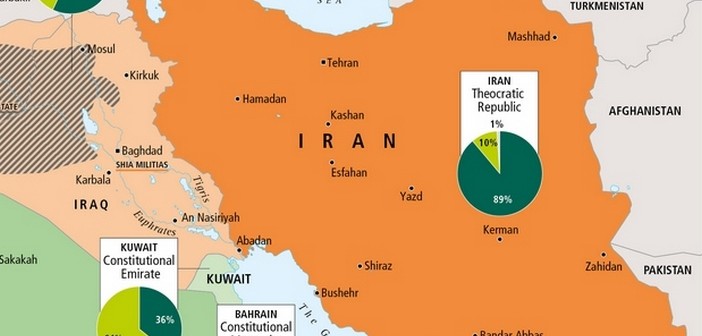
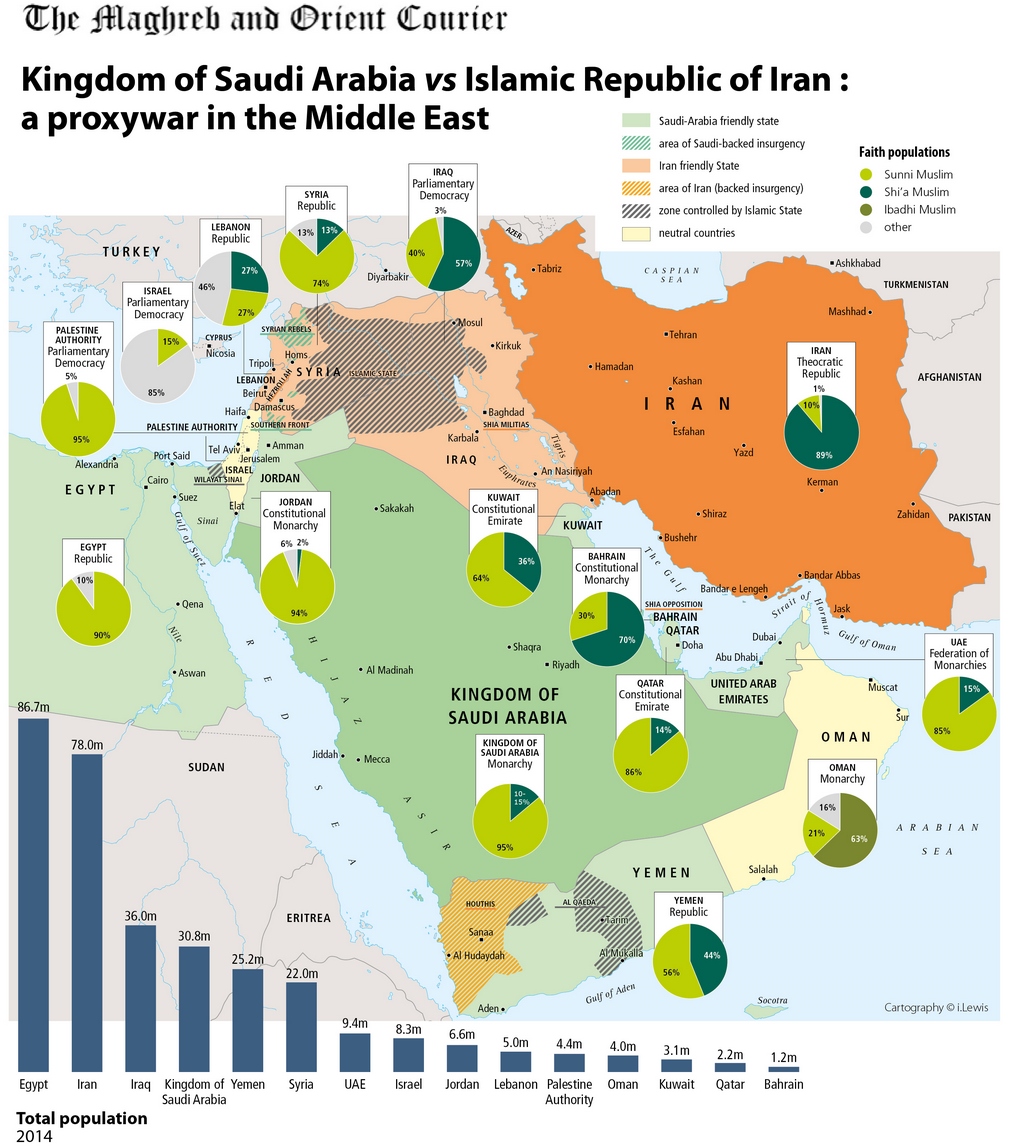

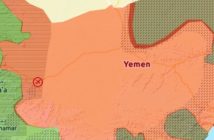
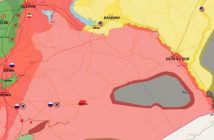
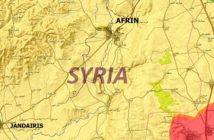
11 Comments
Very accurate and unbiased article, love it! I noticed an error in the map. The “Persian Gulf” is labeled as “The Gulf”. The name Persian Gulf has been used in official maps, google maps and also on the World Atlas website. (http://www.worldatlas.com/aatlas/infopage/persiangulf.htm) Just wanted to pint it out. Great read all and all though.
Pingback: Agathocle de Syracuse | ARAB WORLD MAPS – A proxy war in the Middle-East
Pingback: Resisting the drumbeat « Susan Barsy
Pingback: This map shows the brewing proxy war between Iran and Saudi Arabia | Vus Times
Pingback: How Saudi Arabia 'pulled a proxy out from under Iran's wing' ~ WISE.FINANCE
Pingback: News-2016-01-14 | SUSRIS
Pingback: News-2016-01-14 | SaudiBrit
Pingback: Le tante mappe del Medio Oriente | Lorenzo Ferrari
Pingback: 6 things Saudi Arabia and Iran have in common | Adelaide Hayes
Pingback: Getting Started with Geopolitical Analysis 8: How Useful are Maps? - GeoMeans
Pingback: Arabia Saudí contra Irán: la verdadera rivalidad en Oriente Medio - Elcano Blog